What Succulents Can You Grow As Bonsais?
If you enjoy this article, you should have a look at some of our other posts in this series:
1. Best bonsai plants for the office
2. Best small bonsais for windowsills
3. What succulents can you grow as bonsais? (you are here) 🌳
4. Best water-friendly bonsais
5. Bonsai linked to better office productivity
6. How bonsai helps with focus and goals
7. Bonsai wedding gift for your colleague
Welcome to the third part of our Office Executive series! In this chapter, we’re addressing growing succulents as bonsai trees.
In most cases, many work officials enjoy having minute cacti or succulents on their desks. While they are certainly adorable, there are some you can grow as bonsais! Their structure and bark look the same as hardwood trees.
However, there are some aspects of succulents that separate them from the usual species you’d choose to bonsai.

Table of Contents
Can a succulent grow into a tree?
When you think of a succulent, it’s best if you don’t imagine the adorable, tiny plants you often find in glass terrariums or small containers. In terms of bonsai, there are some species you can develop to look like hardwood trees. Some of them grow into massive sizes, and you wouldn’t think they form part of the succulent group.
Succulent bonsai are popular with beginners and experts. They’re easy to grow from seed and cuttings, while it takes almost no effort to care for them. You can also try various styles, as their stems and branches are incredibly flexible. However, that doesn’t mean they can’t break.
One benefit of a succulent bonsai is that you can plant any pieces that you prune or break. The wounds heal exceptionally well, so you can also display scars or repair a fracture. Several species also have stunning flowers.
What Succulents can you grow as Bonsais?
Now that we’ve shown you how you can grow them as trees, it’s time to share which succulents you can grow as different types of bonsais. We have a few favorites, but we’ll share a few strange ones too. You can even grow some of these to complement your other hardwood bonsais.
Just remember that each species has a specific requirement for you to maintain them. We’ll try to touch on these before giving you some general bonsai tree care principles.
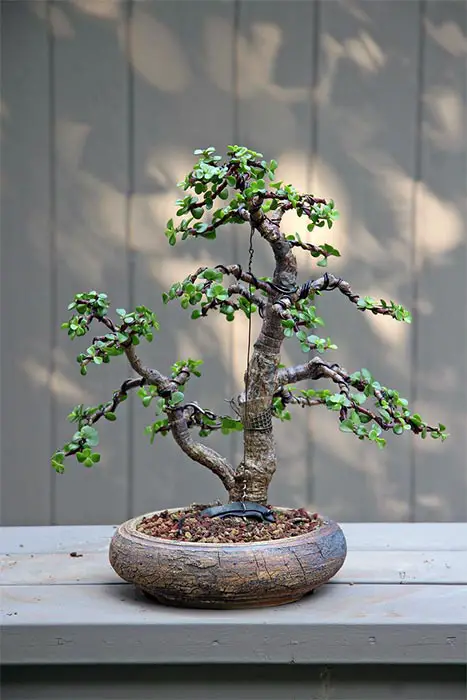
Image courtesy of 4.0 International
Elephant’s Foot / Jade Plant (Portulacaria afra)
Also known as Porkbush and Spekboom, the Jade Plant is a succulent that’s native to South Africa. However, there are many countries where these beautiful specimens are found and grown as bonsai. You’ll more than likely find it in an online store or a local seller who grows rare species for your region.
The Jade Plant bonsai tree has a red-brown stem with bright green leaves. It’s an evergreen succulent, so it won’t change the leaf color or drop any leaves during autumn and winter. When it blooms, you’ll see pink, star-shaped flowers that attract insects due to the delicious nectar.
The succulent bonsai loves being outside or in as much direct light as possible. If the leaves aren’t as green as they should be, the chances are that it’s lacking sunlight. You can freely water it daily in the hot summer but cut back in winter so it doesn’t collect too much liquid.
Bonsai Crassula / Jade Bonsai (Crassula sarcocaulis)
The Bonsai Crassula is often mistaken for Crassula ovata, another favored succulent to grow as a bonsai. It’s an evergreen shrub that generally grows in rocky landscapes or the sides of mountains, which gives it an exotic aspect. It grows well in tropical regions, specifically where you find vast mountain ranges.
Of course, you’ll more than likely find it at your local garden store. Its small clusters of bellflowers range in color, which makes them remarkable for your office desk or windowsill. It has tiny leaves, which is the main element separating it from the C. ovata.
Your Jade Bonsai will want direct, full sunlight for most of the day. There’s little chance of the leaves burning, and it enjoys the heat and can handle some frost. Be careful of overwatering, as it may destroy the trunk. Also, you’ll need to prune any top-heavy foliage to prevent branches from snapping
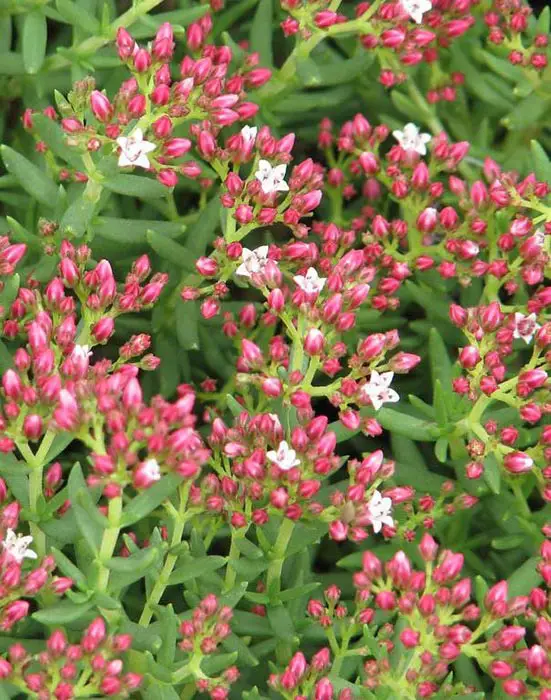
Image courtesy of 4.0 International
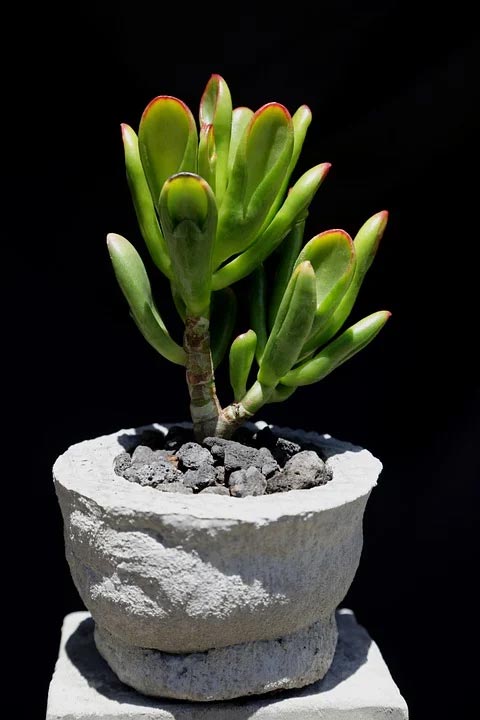
Gollum Jade Bonsai (Crassula ovata ‘Gollum’)
The Gollum Jade Bonsai is also called a Money Plant, not to be confused with the Money Tree Bonsai, Pachira aquatica. The name Gollum comes from the Lord of the Rings franchise, after which several Crassula sub-species receive their titles. Many people believe the plant is a symbol of good luck.
The reason for the name is due to how disfigured the stem and leaves look, which is similar to the titular character from the novels and movies. The leaves are tubular and bright green, with red tips at the top. As with Crassula sarcocaulis, it produces clusters of pink or white flowers that look like small stars when they open up.
The depth of the color depends on how much sun the bonsai gets in your office. If there’s partial shade or indirect light, the leaves will be darker. The more sunlight it receives, the lighter the leaves and the more defined the red tip. The Gollum Jade prefers direct sunlight, but it can manage indoors.
Miniature Pine Succulent (Crassula tetragona)
If you’re looking for an office succulent bonsai that looks like a pine tree, we recommend Crassula tetragona. The name is from how the leaves are crossed, similar to some conifers. While it’s seen as an ornamental plant, there were some who used it for medicinal use in the past to deal with stomach issues.
While the leaves look similar to Crassula sarcocaulis, they are longer and slender. The foliage also presents a bushier appearance, making it denser with the patterns around the stems. The flowers have the same bell-shaped clusters that open up as white stars when they bloom.
It isn’t hard providing the correct bonsai tree care with this succulent. The best watering technique for it is the soak and dry method. You let the pot rest in a tub of water and then let it dry out for a few days. If you’re keeping it in the office, ensure it has a window that provides direct light for a few hours per day.
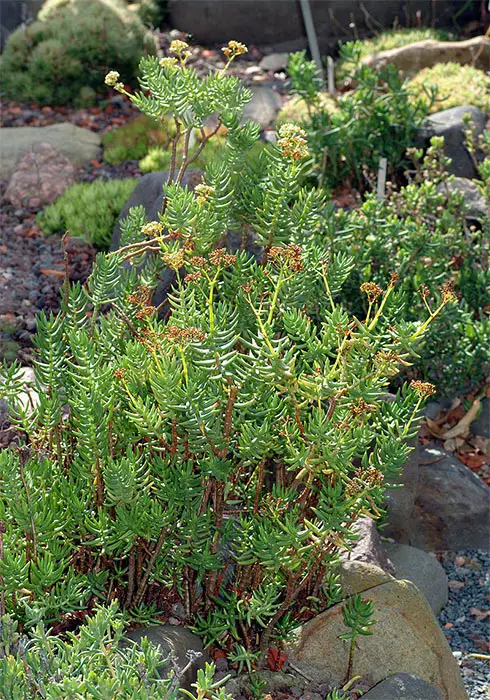
Image courtesy of 4.0 International.
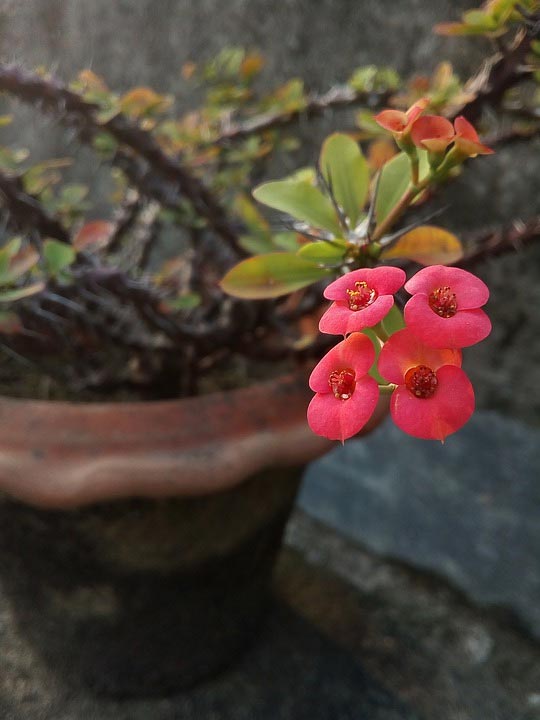
Crown of Thorns (Euphorbia milii)
Many people don’t realize that the Crown of Thorns is succulent at first, as the branches are well hidden beneath the leaves, thorns, and flowers. In Thailand, there’s the belief that you’ll receive as much luck as the flowers it produces. The name is from the red bracts and thorns that are reminiscent of the ‘crown’ Jesus wore during the crucifixion.
The green leaves are spaced around the thick branches, where you’ll also find the long black thorns. You may mistake the red bracts as flowers, but the flowers are actually yellow held within these modified leaves used to attract pollinating insects. It’s similar to the bracts on a Bougainvillea.
The Crown of Thorns is ideal for offices where you want to add some red to the room’s theme. It needs direct sunlight for several hours in the morning, while you’ll need to ensure the soil drains well. It doesn’t like the roots lying in moisture all day. You can easily propagate it from cuttings and seeds to make a small bonsai hedge.
Poinsettia (Euphorbia pulcherrima)
As part of the spurge family, Euphorbiaceae, the Poinsettia has a Christmas theme with red and green colors, and it’s welcome in the office during the festive season. The name is from Joel Roberts Poinsett who is said to have brought this beautiful plant to the United States in the 1820s.
While the green leaves are massive, you can prune the stems until they grow smaller. It has flaming red bracts that really stand out and will be the main attraction in your office or home. In the center, you’ll see small yellow flowers, hidden within the bracts that serve to attract insects.
When pruning, be sure to wear gloves, as the Poinsettia produces white sap that may cause irritation or a rash on your skin. You should also wash your tools before using them with other bonsais, as it may damage them or affect growth. Ensure that the soil remains moist and there’s adequate sunlight.
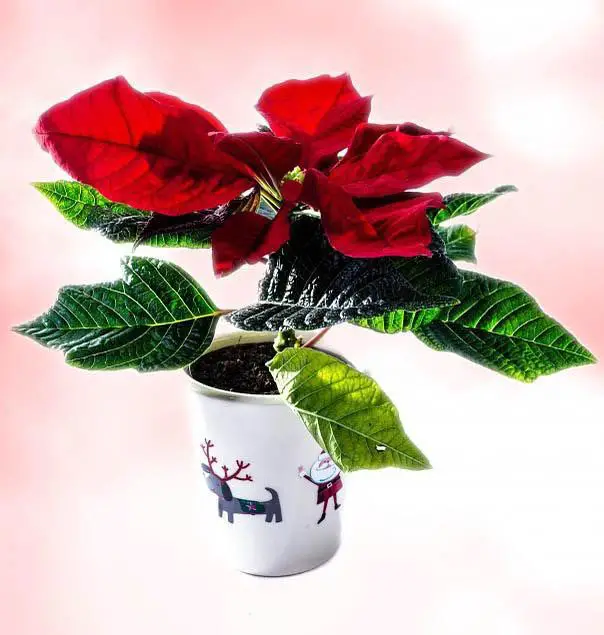
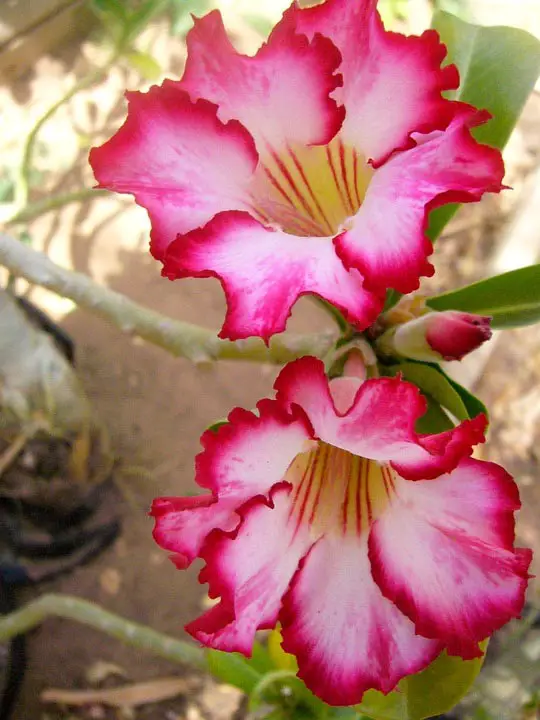
Desert Rose (Adenium obesum)
This gorgeous succulent is known by many other names, such as Kudu, Sabi Star, Mock Azalea, and Impala Lily. It mainly grows in the Sahara region in Africa, South Africa, and the Arabian Peninsula. Many people create hybrid versions so that they can achieve various unique flower colors.
In its natural state, it has dark green leaves that are evergreen. They’re complemented by pink, trumpet flowers in summer. With proper care and maintenance, you can reduce the large leaves and petals to smaller sizes suitable for a bonsai. It has a thick trunk that’s easy to identify as succulent.
Since it’s a tropical plant, it enjoys being indoors in warm environments, which makes it ideal for offices. You’ll need to provide it with plenty of light, preferably on a windowsill facing the south if you’re in the Northern Hemisphere. In summer, you’ll need to water daily to keep the soil moist, while winter will need it about twice a week.
Queensland Bottle Tree (Brachychiton rupestris)
This stunning succulent is part of the mallow family, Malvaceae. It received its name due to the bulbous trunk that tapers up to look like the neck of a bottle. Unlike the other succulents on our list, the Queensland Bottle Tree is deciduous and loses its leaves in winter. It prefers drought conditions, similar to where it grows natively in the dry regions of Queensland.
You’ll find an array of interesting colors that may match your desk. The thick trunk is dark brown or grey, while the much thinner branches are lighter in hue. It has dark green leaves, while you’ll see yellow flowers that have some red markings on them. The follicles look like boat-shaped fruit, which makes an interesting addition to the bonsai.
As it’s used to a drought environment, you’ll need to keep the temperature warm in summer and provide as little water as possible. Feel the soil to see when it’s dry and then add only a small bit of liquid. If you think it’s drying out, you can give it more.
The most important aspect is maintaining the tree size so it doesn’t grow too big for the pot. It only needs light pruning, and your attention will mostly focus on the foliage and keeping the leaves in shape.

Image courtesy of 4.0 International.
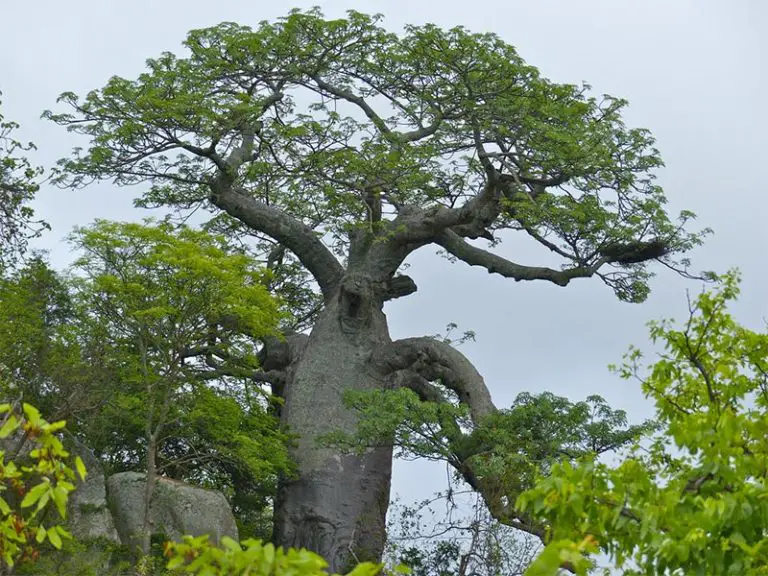
Image courtesy of 4.0 International.
African Baobab (Adansonia digitata)
The Baobab is often mistaken for a hardwood tree. However, it’s semi-succulent in nature. As with the Queensland Bottle Tree, it has a unique shape that makes it popular as a bonsai. Some superstitions and beliefs tell a tale of how God planted this species upside down due to how it looks.
The leaf structure has five leaflets, which provide dense foliage that makes it look outstanding as a bonsai. The roots can grow above the soil if you want to expose some of it for an elegant display. It has massive white flowers in summer, which is the main attraction of the season.
The seeds are easy to propagate after soaking and placing in an upper-layer bed of river sand. You’ll need to keep it in a warm indoor area for most of its sapling years, while you should ensure there’s sufficient sun. You only need to water it as soon as you feel the soil is dry.
Ponytail Palm (Beaucarnea recurvata)
While this species may make you think it’s a true palm, it actually isn’t. The Ponytail Palm is part of the asparagus family, and it has a thick bulb at the base of the stem that collects water. Many people love to place this bonsai in their office for its stunning appearance and easy maintenance.
The evergreen leathery foliage droops down at the top, which gives it that palm appearance. Some enthusiasts let it grow in the garden first before repotting it in a bonsai container. You’ll see flower and fruit spikes in summer, which you should remove as soon as it’s done growing to promote leave and stem health.
The bonsai grows slowly, so you won’t need to prune or water it too regularly. However, it does enjoy plenty of water in the summer, which it stores in the trunk. It will also enjoy you running your fingers over the long leaves, sharing your energy while keeping the blades clean. It loves the sunlight, so makes sure it receives enough during the day.
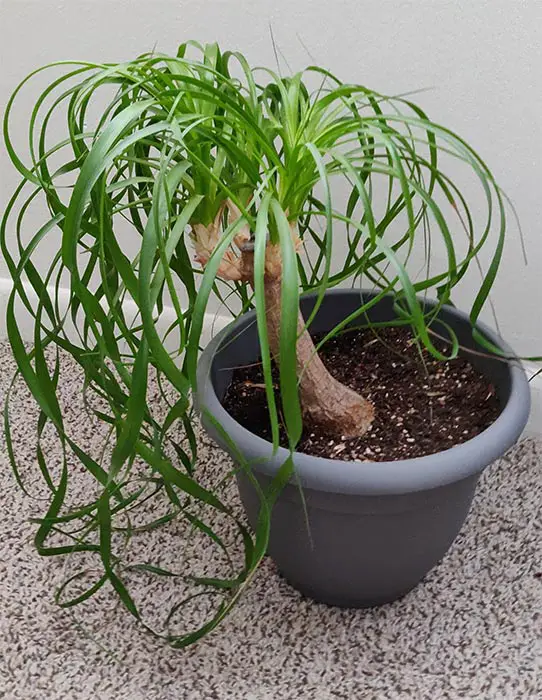
Image courtesy of 4.0 International.
How to Make a Succulent Bonsai
If you want to grow succulents as bonsais, there are different approaches you can take. The first is seed propagation, which is different for every species. For many of them that had hard seeds, you’ll need to soak them first before placing them in the soil.
You can also use cuttings, which you may need to dry the scars until they close before lying them on the soil. In these situations, you’ll wait until roots appear before closing them up. Other trees that are more hard in nature may require rooting hormone or resting the lower end in water.
Of course, you could just buy a succulent that’s small in size and place it in a bonsai container for the easiest approach.
Basic Principles for Succulent Bonsais
As soon as you have your succulent, there are some basic principles you should adhere to if you want to develop it properly:
- Form and shape: Most bonsais have a triangular shape that tapers to the top. However, succulents usually have a broom or umbrella style, while others have pine-like forms. You’ll need to design your tree according to the species standards.
- Balance and symmetry: While you’ll focus on symmetry for hardwood trees, you’ll go for asymmetrical with succulent bonsais. You should also ensure that there’s some sort of balance and that the branch ends don’t become too heavy. The soft interior will snap easily.
- Line and relativity: It’s best to keep a proportionate line in relation to the branches and trunk. The branches should always be thinner than the main stem, while any branchlets will be smaller. Don’t allow upper branches to become thicker.
- Size and overall appearance: Your main goal is to develop a design that makes your succulent bonsai look attractive and appealing. While the leaves and flowers may grow large in nature, you’ll need to prune and maintain them so they remain small. If the roots are massive, you can go for an exposed-root style to give it more space in the soil.
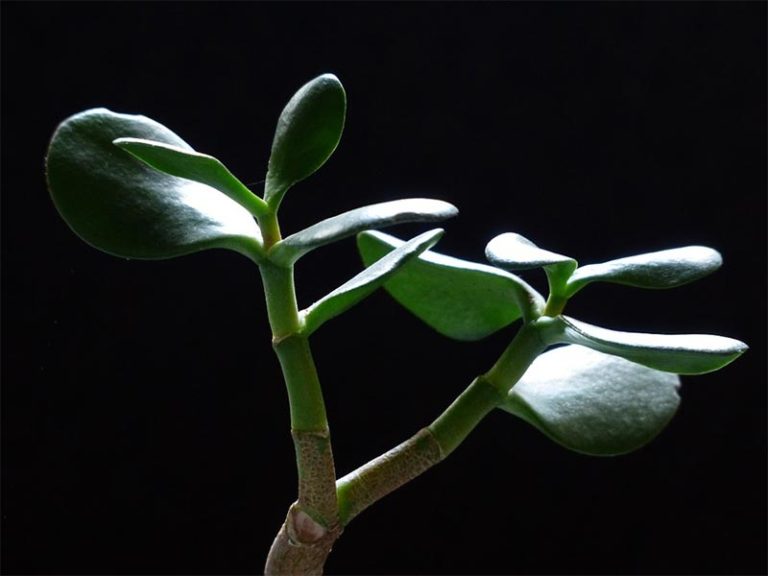
Growing Succulents as Bonsais
Once you’ve succeeded in acquiring a succulent bonsai, it’s time to cultivate and grow it into the tree you want it to be. There are several aspects you need to keep in mind, besides the ones we mentioned for the specific species above. We’ll try to cover as many elements as possible.
How Do You Water A Bonsai Succulent?
When it comes to succulent bonsais, there’s a real danger of watering it too much rather than too little. These small trees enjoy soaking and storing the liquid within the trunk. If you provide too much, the stem may burst open or snap in the center.
We recommend only watering when you feel the top 3 inches of the soil is dry. If you have a drought-resistant bonsai, you may want to wait a bit longer. However, watch for signs that leaves are shriveling or drying out as an indication that it’s thirsty.
Can Succulents Grow In Bonsai Soil?
Succulent bonsais enjoy growing in a bonsai medium. The main reason is that it’s designed to have sufficient drainage, which is ideal. There’s also enough air circulation if you have bark or stones in the substrate, giving the roots enough space to breathe.
If you want to improve soil conditions, you can add drainage stones at the bottom of the pot. It also enjoys the nutrients found in bonsai soil, but it doesn’t hurt to add some fertilizer.
Can I Cut A Succulent That Is Too Tall?
Some of the succulent species we mentioned have a tough stem, while others are soft. If you find that your bonsai is too tall, you can use a sharp, clean knife to make a horizontal cut. It will keep the wound small and prevent any dirt from entering it.
You may find that the stem is thin at the top where you want to divide it. If you’re tempted to pinch it off as you would with the soft branches, think again. You might end up squashing the opening, which may cause damage to the upper end. We recommend cutting it instead.
How Do You Train Succulents?
Training succulent bonsais are essential if you want to get the right shape. You can use the clip and grow technique, as these species aren’t fond of wiring. In this way, you can obtain the desired form without harming your tree.
In essence, you’ll remove new shoots where you don’t want them, and trim the ones on the right spots. When a branch had developed several nodes, you can cut it back to encourage new branchlets. You’ll need to ensure that stems don’t cross over each other for the ideal bonsai shape.
Is It Bad For Succulents To Flower?
No, as succulents often put on a beautiful display when they flower. You can leave them to grow and develop further. Some of them have spikes that reach high, inviting insects to pollinate them. If you keep them in your office with closed windows, there’s a low possibility of the flowers turning into fruit with seeds.
The only issue is when the blooming period is over. The remaining flowers look terrible and may produce a foul odor. You’ll want to remove them as soon as they start looking bad, as it may affect the health of your succulent bonsai.
What Is A Succulent Death Bloom?
Monocarpic succulents are plants that die soon after their first flowering. The main reason for this is so that it can encouraging the development of the pups after it has died. Fortunately, none of the species we’ve recommended in this article have a death bloom.
So, how do you know if your succulent has a death bloom? The flowering stalk will originate from the center of the plant. If you see the stalk appear on the sides, it’s safe and will continue living after the flowers have disappeared. For monocarpic plants, the stem and leaves will become black, and you can throw them away or bury them.
How Long Do Succulent Terrariums Last?
It’s an excellent experience to grow a succulent bonsai terrarium. In theory, they can live for several decades, with the oldest known one being more than 50 years old. However, it all depends on the conditions inside, and whether it’s a closed or open environment.
Many sellers have open succulent terrariums with the stems extending past the opening. However, closed environments eventually succumb to rot and mold if you don’t have sufficient light. You should also open the lid once in a while to let in some fresh air.
Can You Cut Off A Piece Of Succulents And Replant Them?
Propagating your succulent bonsai will depend on your species. For some of them, you can remove the leaf from the stem and leave the opening to become a closed scar. After placing it on soil, you can spray water over it until roots appear.
Some species have a more hardwood appearance. In these cases, you’ll need to make a clean cut across the stem and place it in the soil. You can also add root hormone on the tip and then water the soil daily. Gently tug the trunk after a few weeks to feel if there’s any resistance of the roots in the soil.
Should I Remove Yellow Leaves From Succulents?
One of the primary reasons for succulent leaves turning yellow is too much water. If you feel the soil and it’s extremely damp, you’ll need to stop watering for a few days. When it feels completely dry again, you can sprinkle it with some water. You should see some green return to the leaves.
Another reason it might becoming yellow is if there’s too much sunlight. You might want to try moving the bonsai to a shaded area for a few hours in the day, specifically peak afternoon. You’ll notice the leaves becoming darker green. If that’s the case, ensure it only receives morning or partial light.
Can You Plant Succulents In Just Rocks?
Your succulent might live in only rocks for a few weeks, but you’ll eventually see it die. The roots need proper stability, while rocks don’t supply the nutrients it needs to survive. While some species do grow from rocks on the mountains, there’s usually some soil or source of food nearby.
Of course, it doesn’t mean you can’t go for a rocky appearance. There are many ways you can grow it like this in a terrarium, while still providing soil mix and fertilizer. In the end, you’ll have a lovely desert look without killing your bonsai.
Do Succulent Plants Need A Lot Of Sun?
Most succulent bonsais love as much sun as you can provide. So, if you have one indoors in your office or home, we recommend placing it as close to your window as possible. If you can put it outdoors or on a balcony, that’s even better.
However, the summer sun can quickly burn the leaves, especially if they’re young. You’ll want to provide at least six hours of light while having shade in the hot afternoon. You can also spray around the bonsai, but make sure the water doesn’t settle on the leaves. It can cause the light to scorch them.
How Do You Bring A Dying Succulent Back To Life?
Killing a succulent bonsai is almost impossible, as they are hardy plants that can survive most conditions. However, there may be few reasons that it’s not doing well. You’ll need to do some observations to find the probable cause.
If you want to perform a complete overhaul, we recommend you move it away from the sunlight first. Next, take it out of the soil and clean the roots and pot. You’ll want the roots to dry completely before you place them back in any new substrate.
You’ll want to place some drainage rocks at the bottom to ensure the water doesn’t rest in the soil, especially with terrariums. Make sure you carefully put the roots in the new soil without harming them. Keep your succulent bonsai in the shade and water sparingly until you see it coming back to life. You can now return it to full sunlight for a few hours.

Final Thoughts
As you can see, it’s fun to grow a succulent as a bonsai tree in your office. If you want to show off to your colleagues, these species will set you apart from the standard versions you usually find on desks or windowsills.







